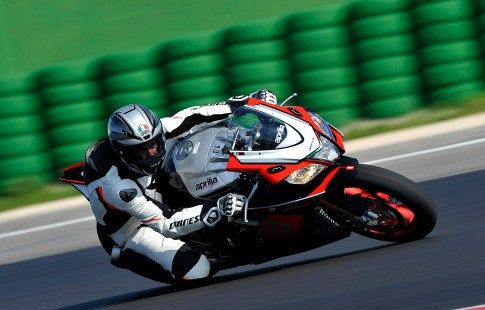Since Aprilia introduced its RSV4 in 2009, the little company from Noele, Italy, has won four manufacturer and three rider titles in World Superbike competition. The RSV4 has been a great platform, and the 2016 version represents another crucial step in the ongoing development of the RSV4 model.
For 2016, the RSV4 comes in two designations—the RR and the limited-edition RF, of which only 500 will be made. The new V-four-powered superbike is not that dissimilar to previous model, but it does have some very important changes, which were made to comply (and exploit) this year’s Superbike rules imposed by promoter Dorna, which allow fewer modifications to the production machines competing in the Superbike World Championship. So, Aprilia has upped its game, with a lighter motorcycle that has more power, better handling, and a more sophisticated electronics package.
The official track launch for the RSV4 took place at the Misano World Circuit, near Rimini, Italy. Our test would include four 20-minute sessions on the RF version. Misano has a nice combination of slow, medium, and fast corners, plus there are a few difficult direction changes combined with plenty of corners that require heavy trail-braking to the apex.
I spent the first session figuring out the layout, and on more than one occasion ran it in way too deep exploring the braking zones. But every time I was able to reel it back in thanks to the RSV4’s excellent front-end feel. The radial-mounted Brembo calipers and 320mm rotors also did an exemplary job. By the second session, I knew where I was going, and I was able to start exploring the limits, thanks to the Pirelli Supercorsa SP race-compound tires.
The chassis of the RSV4 has always been its strongest asset, but I had forgotten about the very smooth nature of the V-four engine, which has always made this Aprilia one of the easiest superbikes to ride fast; the more you push, the better it feels. Eventually though, the euphoria was over and I was giving it enough throttle to get the back end to start squatting on corner exits. The Aprilia mechanics on hand took note of my situation and before the third session added some compression and took some rebound out of the Öhlins shock, which is standard on the RF.
With the chassis to my liking, it was time to investigate Aprilia’s latest version of its race-developed APRC (Aprilia Performance Ride Control) system. APRC integrates the full ride-by-wire, multi-map, electronic-engine management system, which has three new engine mapping settings: S (Sport), T (Track), and R (Race). The corresponding engine-braking maps are new, as well, with engine-braking lessened at 6,000 rpm and beyond. The system also offers ATC (Aprilia Traction Control), AWC (Aprilia Wheelie Control), ALC (Aprilia Launch Control), AQS (Aprilia Quick Shift), and Race ABS.
The engine itself has been substantially updated with a new crankshaft, new Pankl connecting rods, and a new cylinder head that now features forged camshafts with titanium exhaust valves joining the ti intake valves residing in CNC-machined combustion chambers. A new airbox, variable-length-intake funnels, and a revised exhaust help the engine breathe.
In the technical briefing, Aprilia’s engineers explained how the new engine-mapping system has been revised for smoother, less aggressive power delivery. The new motor puts out a claimed 201 horsepower (16 more than the previous model), and yes, the throttle response is quite good, with power delivery very linear throughout the rev range. Never once did I feel a hesitation or lack of grunt; there isn’t a big hit of power anywhere, it just keeps pulling until the end of the rev range.
I headed out for my third session with the ATC set on 3, AWC on 1, and in the R map (the most aggressive). The revised slipper clutch and updated engine-braking mapping worked well together. I found that the RSV4 likes to wag its tail ever so slightly, but stays in line just enough to let you get into the corner as late as possible. Even with the front-end buried on the brakes, you can still get the bike turned and finish the corner. The fact is, it feels like a properly setup race bike right out of the box.
For my final session, I thought about taking some preload out of the fork as the rear end was still squatting a bit. My technician instead decided to lower the front end by 5mm, which turned out to be the fix I was looking for. The bike felt more composed on the exits without losing any of its front-end feel. I thought it might make the geometry too steep under heavy braking, but I was wrong; you could still put it where you wanted entering the corners. With this new bike, Aprilia’s engineers were looking for improved stability, while not sacrificing any of the agility for which the RSV4 chassis is known. I believe they met their goal.
As far as the new electronics go, the only real problem I noticed was the way the eight-position traction control reacted to the loss of grip. It would cut the power ever so slightly causing the bike to stutter exiting the corners. The three-position wheelie control felt much the same and sometimes it was hard to distinguish the difference between ATC and AWC.
Aprilia has done its homework and managed to improve what was already a fabulous motorcycle. The chassis as a whole felt excellent and the drivability of the new engine is smooth, precise, and powerful. The RSV4 remains a serious contender for top honors on the street, and as this season’s World Superbike Series has shown, is still quite effective on the racetrack, too.










24
Comment